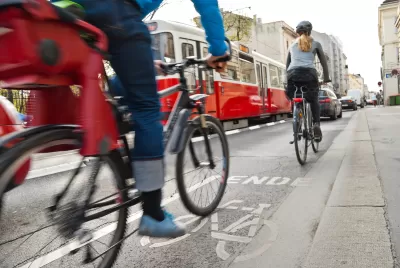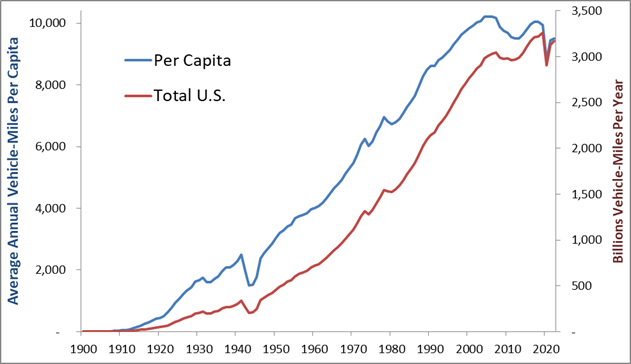There is evidence that automobile travel is peaking while demand for non-auto modes is growing, but double-check your data sources to be sure.

The National Household Travel Survey (NHTS) is a detailed study of travel activity sponsored by the U.S. Department of Transportation. Results of the 2022 version were recently released, including the following graph which shows a huge (38%!) decline in average trips per capita by all modes.

This was cited as proof of peak car and an overall decline in out-of-home activities in Angie Schmitt’s recent article, Nobody's Leaving the House Anymore.
However, as Joe Cortright points out in Bad Data: Not a Decline in Travel, this probably reflects major changes in the survey methodology (previous versions relied on a travel diary in which participants recorded their travel activity when it happened, the 2022 version had them recall trips they made the previous day, a much less reliable method) rather than actual changes in travel activity. Joe provided the following image.

However, other, more reliable data sources also indicate that per capita automobile travel is peaking while demand for other modes is increasing, as discussed in my report, The Future Isn't What It Used to Be: Changing Trends and Their Implications for Transport Planning. This reflects a combination of factors including vehicle travel saturation, aging population, rising fuel prices, increased urbanization, changing consumer preferences, improved accessibility options (such as telework, work-at-home and e-bikes) and more multimodal transportation. Automobile travel will not disappear, but it indicates that many people would prefer to spend less time and money on driving, and rely more on walking, bicycling and public transportation, provided they are convenient, comfortable and affordable.
In fact, per capita vehicle travel peaked in the US in 2006 and has declined somewhat since, as illustrated in the following graph.
U.S. Annual Vehicle Travel (FHWA)

Our regional travel surveys here on Southern Vancouver Island shows similar trends. Per capita automobile travel peaked about 2006 and subsequently declined, particularly in communities that improved non-auto travel options. Similar reductions are occurring in other North American communities.

This is good news overall. It indicates that given better options travelers will drive less and rely more on non-auto modes, helping to achieve sustainable transportation goals including local economic development, increased affordability, improved public fitness and health, and environmental protection.

Alabama: Trump Terminates Settlements for Black Communities Harmed By Raw Sewage
Trump deemed the landmark civil rights agreement “illegal DEI and environmental justice policy.”

Planetizen Federal Action Tracker
A weekly monitor of how Trump’s orders and actions are impacting planners and planning in America.

The 120 Year Old Tiny Home Villages That Sheltered San Francisco’s Earthquake Refugees
More than a century ago, San Francisco mobilized to house thousands of residents displaced by the 1906 earthquake. Could their strategy offer a model for the present?

In Both Crashes and Crime, Public Transportation is Far Safer than Driving
Contrary to popular assumptions, public transportation has far lower crash and crime rates than automobile travel. For safer communities, improve and encourage transit travel.

Report: Zoning Reforms Should Complement Nashville’s Ambitious Transit Plan
Without reform, restrictive zoning codes will limit the impact of the city’s planned transit expansion and could exclude some of the residents who depend on transit the most.

Judge Orders Release of Frozen IRA, IIJA Funding
The decision is a victory for environmental groups who charged that freezing funds for critical infrastructure and disaster response programs caused “real and irreparable harm” to communities.
Urban Design for Planners 1: Software Tools
This six-course series explores essential urban design concepts using open source software and equips planners with the tools they need to participate fully in the urban design process.
Planning for Universal Design
Learn the tools for implementing Universal Design in planning regulations.
Clanton & Associates, Inc.
Jessamine County Fiscal Court
Institute for Housing and Urban Development Studies (IHS)
City of Grandview
Harvard GSD Executive Education
Toledo-Lucas County Plan Commissions
Salt Lake City
NYU Wagner Graduate School of Public Service





























